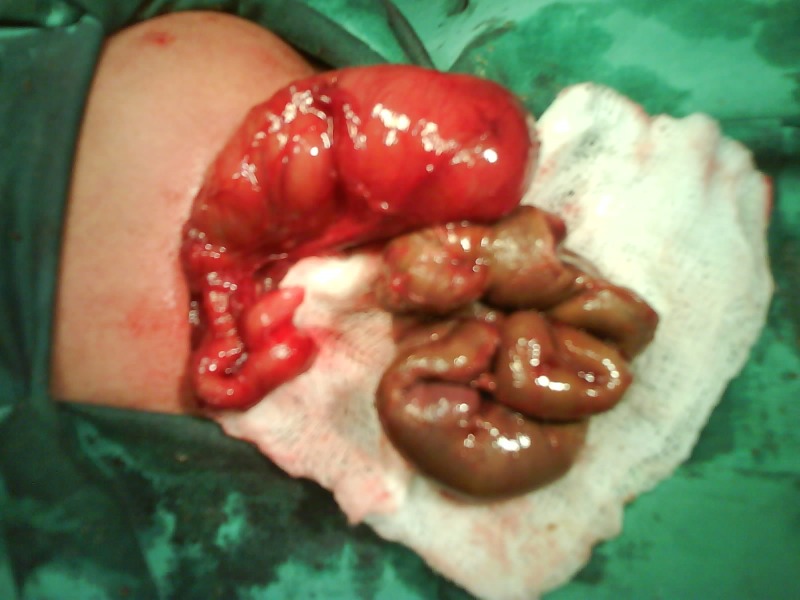Figure 1
A 3-day-old male baby was diagnosed to have proximal small bowel atresia. At operation type-IIIa jejuno-ileal atresia (JIA) was encountered with a jumbled up sequestered bowel-loop-mass. The jejunum was 10 cm and ileum merely 1 cm. The bowel was sequestered on account of volvulus in-utero.
Atresia is derived from Greek words “a” (no) and “tresis” (orifice); and refers to congenital obstruction of intestine due to complete occlusion of the bowel lumen. JIA is most common variety of intestinal atresias followed by duodenal atresia [1,2]. The type-IIIa atresia typically develops due to in-utero volvulus of small bowel, there¬fore, usually associated with short bowel [1]. Intraute¬rine volvulus is the etiology in 25% cases of JIA. As all the cases of JIA, resulted from in-utero volvulus of small intestine, are not associated with malrotation, therefore, in-utero volvulus may develop secondary to the atresia itself where the dilated bowel can twist around its me-sentery. However, atresia can also develop secondary to volvulus even in absence of malrotation. This is especially seen in cases of meconium ileus wherein the meconium laden loop twists around its mesentery resulting in atresia, peritonitis and/or meconium cyst [3-5]. The sequestered bowel may resorpt partially or completely. Indeed complete resorption occurs in majority, however, when the event of volvulus and atresia occurs late in gestation the necrotic bowel may be present at birth.
Footnotes
Source of Support: Nil
Conflict of Interest: None declared
References
- 1. Warner BW. Jejunoileal atresia. In O’Neill JA Jr, Rowe MI, Grosfeld JL, et al (eds): Pediatric Surgery, 6th ed. Chicago, Year Book, 2006, p 1369-82. [Google Scholar]
- 2. doi: 10.1001/archsurg.133.5.490. Vecchia LKD, Grosfeld JL, West KW, Rescorla FJ, Scherer LR, Engum SA. Intestinal atresia and stenosis: a 25 year experience with 277 cases. Arch Surg 1998;133:490-7. [DOI] [PubMed] [Google Scholar]
- 3. Sarin YK. Intrauterine intussusception causing ileal atresia. APSP J Case Rep 2010; 1:18. [PMC free article] [PubMed] [Google Scholar]
- 4. doi: 10.1016/j.jpedsurg.2004.08.037. Komuro H, Hori T, Amagai T, Hirai M, Yotsumoto K, Urita Y, et al. The etiologic role of intrauterine volvulus and intussusception in jejunoileal atresia. J Pediatr Surg 2004;39:1812-4. [DOI] [PubMed] [Google Scholar]
- 5. Kayastha K, Mirza B, Sheikh A. Volvulus of small bowel in a case of simple meconium ileus. APSP J Case Rep 2011; 2:7. [PMC free article] [PubMed] [Google Scholar]



